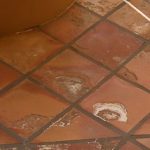Flooring in residential projects is a direct reflection of changes in trends as they are happening in the design-build industry. When I was first doing interior design in the early 80’s, wall to wall carpeting was almost the only thing we used except in bathrooms, kitchens and foyers. Thank god that’s in the past! Then we got hooked on ceramic tile, and although it’s hard to believe, we actually used 8″x8″ and 12″x12″ ceramic tile on floors, and to make it worse, they often had large, contrasting grout joints! At that time wood floors, at least here in the west where I’ve been practicing (Colorado and Arizona), were usually delegated to offices and libraries in my clients’ homes. (Now, with the introduction of such a variety of engineered wood floors in a huge range of pricing, wood flooring has become more and more popular in place of wall to wall carpeting for bedrooms and main living spaces.)
Fast forward to the late 80’s and early 90’s, and here in Arizona we were using locally sourced flagstone floors, often in random shapes, ceramic tile in a little larger sizes (but usually still pretty ugly), and our Southwestern specialty, Saltillo tile. We wore that idea out until we were all sick of it, with the “bubblegum” technique on Saltillo (essentially whitewashing it and turning it pink), staining it so it became darker, using linseed oil on it so it became really dark, and suffering through the inevitable “lime pops” caused by efflorescence because Saltillo and all terra cotta tiles are not fired at a high temperature. Still, it’s a good product for a more organic or Southwestern design style, and many of the Saltillo and other terra cotta products that are coming now are less likely to stain and lime pop. As a side note, Saltillo is NOT a good product to use around a pool, because when wet the surface is very slippery. Often, it has been used upside down to alleviate that problem and also to provide a cooler surface to the feet around a pool, but I don’t recommend it because it tends to deteriorate in a few years when exposed to constant moisture (even from a sprinkler head).
Then came the era (which is still going on) of travertine tiles in all shapes and sizes and colors and thicknesses….pillowed surfaces, chiseled edges, travertine mosaics, travertine liner bars and anything else you can possibly imagine made of travertine. It’s a very versatile natural material that adapts well to many different design styles, and it is neutral in color which adds to its flexibility. Lesser quality travertine has large “holes” in it that I prefer to fill with grout, which eliminates the chance of dirt collecting in the hole or a stiletto heel getting caught in it. However, the downside of grouting in the negative spaces is that grout tends to stain more easily than the stone itself, so over time you will see the grouted-in areas getting more and more dirty. The trick here is to keep it sealed, or purchase travertine that is “filled” at the factory, where they use a more durable epoxy mixture to do the filling.
The very best choice when using travertine as a flooring material is to select a higher quality, such as Durango Stone from World Wide Stone, which is more dense, and higher quality travertine than many others, including Turkish travertine. These beautiful flowing stairs are made of such high quality stone that they look and feel like marble,and add elegance to any home.
As a high-end designer, we try to stay ahead of trends, and travertine has become a trend. We have therefore moved on to other options in an attempt to always offer our clients the latest and best flooring possible. When travertine became so popular, we started searching out limestone flooring materials, which traditionally had come from France and were very pricey. However, with the new interest in a beautiful, neutral colored stone with a soft pattern movement, rather than the blotchy pattern of many of the travertines we had been using, many stone suppliers searched out new sources for limestone, and we now have new sources of limestone from India, Portugal, Spain, Israel, Mexico and other countries.

Linear veins in vein cut travertine give the opportunity to create interesting patterns, such as this herringbone pattern.
The latest movement in design has been a massive shift, since the Great Recession, toward cleaner, more simple design, which often translates to more “Contemporary”. We are looking now for linear designs in stone (as opposed to mottled), or almost no design at all. A relatively new way to use travertine has answered this call with the introduction of “vein cut” travertines, with a linear pattern, as opposed to “cross cut” travertines…..same stone, different direction of cutting the tiles or slabs, which completely changes the look of the stone. With the linear pattern, we can use large tiles, laying them all the same direction which creates a smooth, flowing look. Or, we can play with the pattern in smaller sizes to create borders and overall patterns, such as this herringbone pattern.

This Athens Silver stone (which is a marble) is a great example of the popular linear stone installed in a running bond pattern.
With the trend to cleaner more contemporary interior spaces, we have also moved to larger and larger floor tiles. It isn’t unusual to see 48″x48″ tiles on the floor of a large room, or the increasingly popular rectangular shape, in a large scale sizes such as 16″x32″ and 24″x48″. These also offer options in pattern layout, with the most trendy look in floor tile currently being large rectangles in a “running bond” pattern. This gives an interesting, and yet very predictable pattern which pleases the eye in many different design environments.
In another blog (coming soon!), I will introduce the newest porcelain tiles, which have become the rage in flooring. The options are endless and staining is not an issue, which has everyone excited about using them in many different types of spaces, both inside and out.




